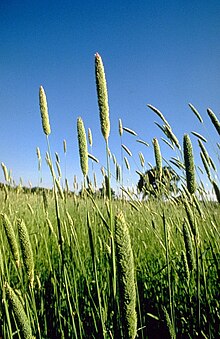Loading AI tools
Genus of flowering plant in the grass family Poaceae From Wikipedia, the free encyclopedia
Phalaris is a genus of flowering plants in the grass family. Species of Phalaris are distributed across all continents except Antarctica. They can be found in a broad range of habitats from below sea level to thousands of feet above sea level and from wet marshy areas to dry places. P. arundinacea and P. aquatica are sometimes invasive species in wetlands.
| Phalaris | |
|---|---|
 | |
| Phalaris aquatica | |
| Scientific classification | |
| Kingdom: | Plantae |
| Clade: | Tracheophytes |
| Clade: | Angiosperms |
| Clade: | Monocots |
| Clade: | Commelinids |
| Order: | Poales |
| Family: | Poaceae |
| Subfamily: | Pooideae |
| Supertribe: | Poodae |
| Tribe: | Poeae |
| Subtribe: | Phalaridinae Fr. |
| Genus: | Phalaris L. |
| Species | |
|
15-22 species (see text) | |
Some Phalaris species contain gramine, which, in sheep and to a lesser extent in cattle, is toxic and can cause brain damage, other organ damage, central nervous system damage, and death.[1][2]
Phalaris arundinacea, Phalaris aquatica, and Phalaris brachystachys are known to contain the alkaloids DMT, 5-MeO-DMT, and 5-OH-DMT (bufotenin). Some research has been done into the variability of alkaloids in the Phalaris grasses. Strains with high levels of alkaloids are best avoided in locations with grazing cattle and sheep, due to potential toxicity. Such high-alkaloid strains include Phalaris aquatica AQ-1 and the species P. brachystachys. Seasonal and weather patterns also appear to affect alkaloid concentration, as most toxicity occurs in autumn and in times of drought. Regrowth after grazing or mowing also shows a considerable increase in alkaloids.
In June 2018, mobs of wild kangaroos were observed[3] suffering from "phalaris staggers" which causes head tremors, a loss of co-ordination and collapse. When phalaris is used to feed livestock, farmers can administer cobalt to their animals or spray it on their pastures to protect animals against the effects of phalaris. However, this treatment is not available to wild kangaroos and they suffer from poisoning due to the alkaloids. The staggers syndrome is more common in livestock in areas with limestone soils, which contain less cobalt than basalt soils.
| Species | Total alkaloids (dried) | DMT | 5-MeO-DMT | 5-OH-DMT |
| Phalaris aquatica | 0.0007-0.18%[4] | 0.100%[5] | 0.022%[5] | 0.005%[5] |
| Phalaris arundinacea | 0.0004-0.121%[4] | |||
| Phalaris brachystachys | Aerial parts up to 3% | x | ||
None of the above alkaloids is said to have been found in P. californica, P. canariensis, P. minor and hybrids of P. arundinacea together with P. aquatica.[4]
Some species are used in dried flower arrangements. Phalaris canariensis is commonly used for birdseed.
Phalaris arundinacea is also being trialled as a potential bioenergy crop in Ireland.[6]
Species include:
Seamless Wikipedia browsing. On steroids.
Every time you click a link to Wikipedia, Wiktionary or Wikiquote in your browser's search results, it will show the modern Wikiwand interface.
Wikiwand extension is a five stars, simple, with minimum permission required to keep your browsing private, safe and transparent.